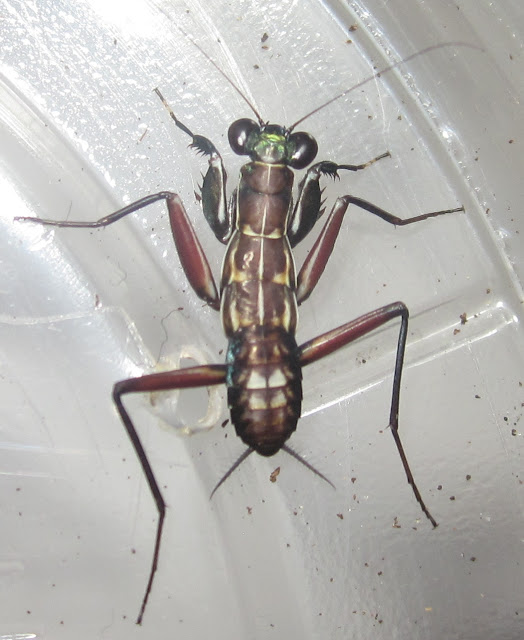I've just completed a trade with fellow hobbyist Tony Shen for a dream species of mine, that I'm stoked to finally be working with! 😁 Introducing, the Splendid Bark Mantis, Metallyticus splendidus! These mantids are more like roaches than almost any other mantids in terms of morphology and overall care, think hardy Zetoborinae setup, lots of flat bark or cork board (they readily accept either) for them to cling to, high humidity, warmth, and at least a moderate amount of ventilation.
However, obviously, unlike roaches, these are predatory mantids, small nymphs will feed readily on springtails, fruit flies, micro-roaches like Compsodes, and firebrats. Larger instars do well on a diet of (former) Ectobiids such as Hemithyrsocera, Parcoblatta, etc., though they'll eat anything they can reasonably catch, crickets, moths, flies, etc..
Like roaches, these CAN be kept communally, with some caveats though.
You have to make sure they're always topped off on food, have lots of hides, and you can't house nymphs of very different sizes with each other (otherwise the larger ones might see the younger instars as food). Additionally, it's advised you keep ooths separately from other nymphs, because even first or second instar nymphs will eat other nymphs as they're hatching from their oothecae, when they're completely vulnerable and haven't fully expanded yet. But for the most part, individuals of the same size can't do much damage to each other, their raptorial arms are so short that they seldom try to take down prey even half their size (in contrast to lots of other mantids, which have eyes bigger than their stomachs... 😂).
Additionally, adult males can be territorial towards each other, though males and females are docile towards each other, and thus extremely simple to pair. It's also a good idea to keep pre-sub or subadult nymphs of both sexes together, because this tends to get them all to sync up in growth and have males and females mature at the same time (some sort of hormonal thing I guess).
One thing to keep an eye on as well, if you keep nymphs communally from a young age, there will likely be a few that stay a bit stunted in growth, a molt or two behind the others. This is likely due to natural competition between the nymphs for territory and food, and so these stunted ones should be isolated if you want them to survive, since they'll likely be stressed to death by bullying, or straight up eaten by their tankmates otherwise.
For all these reasons, when just starting out with this species, personally I'd recommend just keeping your starter group of nymphs isolated from each other, until they hit pre-sub size or larger, just to be safe. These are quite rare and expensive in the hobby ATM, so every nymph counts!
Here are some other noteworthy tips I picked up from my friend Brandon Maines at Magnificent Beasts, who bred this species for three generations and only lost them due to a series of unfortunate events regarding husbandry.
- Don't overfeed gravid females. This is very important, because they can actually get eggbound quite quickly if fed too much, and die as a result.
- They aren't super picky about food. Basically anything they can hold in those stubby little raptorial arms of theirs, they'll eat. Some people insist the only food they'll reliably feed on, particularly when young, is firebrats, but those people must not keep much springtails or micro-roaches. Brandon's three generations of feeding nothing but springtails and roaches throughout their life cycle proves this assumption wrong, most mantid breeders just don't work with any feeder roaches besides the most basic and common ones (most of which aren't all that great for mantids when compared to all the more obscure, soft shelled little Blattelliids and Pseudophyllodromiids in culture, not to mention Compsodes).
- Inbreeding is not typically an issue. I mean this goes without saying for most inverts, but mantid keepers are quicker than most to blame inbreeding for culture crashes after a few generations (when it's usually just husbandry issues). Again, Brandon bred this for three generations, starting from a single ooth... And the loss of his culture was due to a combination of overfeeding his females, letting nymphs stay communally with ooths (which led to the vast majority of that generation being cannibalized as they hatched out), and then getting unlucky with only having male nymphs after that. 😅 But yeah, he never had to add new blood or anything, and they did just fine regardless.
Anyways, I've got my five nymphs set up in moderately ventilated containers with a thin layer of coconut fiber substrate, with some flat bark and corkboard hides. I'm keeping them humid, and at around 75-85F°. I'm currently feeding them Coecobrya and Compsodes.
Here are some pictures of the little cuties:
 |
| Here's one nomming on a Compsodes schwarzi nymph |
Beautiful patterning even on these small nymphs, and they already have metallic green heads. 🥰 Adults have fully metallic wings, with males being blue in coloration, and females a beautiful green and red. Here's hoping I can rear these up to adulthood, and breed them afterwards! 🤞 😁
Well, that's gonna do it for this post, thanks for reading, hope everyone enjoyed, stay safe, and I'll see you all next time! 😉










No comments:
Post a Comment